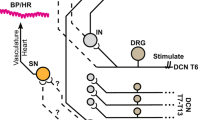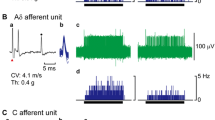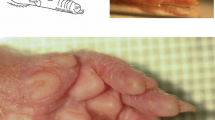Abstract
Previous studies indicate that the withdrawal reflex system in the rat has a “modular” organization, each reflex pathway performing a specific sensorimotor transformation. Here, we wished to clarify which cutaneous receptors contribute to this system and to determine whether there are differences in this respect between reflex pathways of different muscles. Withdrawal reflexes of the peroneus longus, extensor digitorum longus, and semitendinosus muscles were recorded with EMG techniques during high reflex excitability in decerebrate spinal rats (n=26). While maintained innocuous pressure on glabrous skin could elicit a sustained reflex activity in all muscles studied, vibration of glabrous skin (10–300 Hz) always failed to evoke a reflex response, suggesting that slowly adapting, but not rapidly adapting, low-threshold mechanoreceptive fibers from this type of skin contribute to withdrawal reflex pathways. Thermal stimulation in the innocuous range, i.e., cooling from 32 to 17°C, or warming the skin from 32 to 41°C, always failed to produce reflex responses, indicating that neither cold nor warm receptors contribute to withdrawal reflex pathways. When either cooling or warming the skin to the noxious temperatures of 1°C or above 45°C, respectively, a reflex discharge was often evoked in the muscles studied. Intradermal administration of histamine, a potent pruritogenic substance, produced very weak, or no, reflex response. In contrast, mustard oil produced vigorous reflex responses in all muscles studied. These findings suggest that some chemonociceptors contribute only weakly, or not at all, to withdrawal reflex pathways. The present data suggest that a selective set of cutaneous receptors contribute to withdrawal reflex pathways and that different withdrawal reflex pathways receive input from essentially the same cutaneous receptor types.
Similar content being viewed by others
Author information
Authors and Affiliations
Additional information
Received: 13 March 1997 / Accepted: 27 June 1997
Rights and permissions
About this article
Cite this article
Weng, HR., Schouenborg, J. On the cutaneous receptors contributing to withdrawal reflex pathways in the decerebrate spinal rat. Exp Brain Res 118, 71–77 (1998). https://doi.org/10.1007/s002210050256
Issue Date:
DOI: https://doi.org/10.1007/s002210050256




